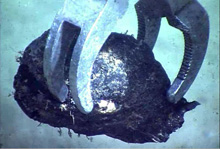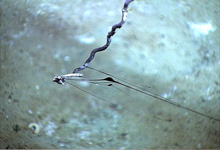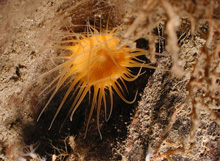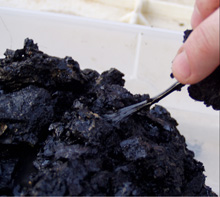After watching a globular rock shatter under pressure from the Jason manipulator arm, scientists were convinced they discovered a rare natural asphalt site. Click image for larger view and image credit.
Scientists got more than they bargained for when remotely operated vehicle pilots plucked this single tubeworm specimen from the sea floor. A small reservoir of thick sticky tar was just below the sea floor. Strung out by the current, the tar eventually stuck to the lens of the science camera. Click image for larger view and image credit.
Lowering Jason to Garden Banks 647
June 26, 2007
Matt Frye
Minerals Management Service
27° 19.73 N
92° 25.69 W
![]() Scientists discover oozing tar in the chemosynthetic ecosystems of the Gulf of Mexico. (Quicktime, 1.8 Mb.)
Scientists discover oozing tar in the chemosynthetic ecosystems of the Gulf of Mexico. (Quicktime, 1.8 Mb.)
![]() Geologists document an accumulation composed of natural asphalt — an exciting find in the northern Gulf of Mexico. (Quicktime, 1.1 Mb.)
Geologists document an accumulation composed of natural asphalt — an exciting find in the northern Gulf of Mexico. (Quicktime, 1.1 Mb.)
During our last year's Deep Slope cruise, aboard the research vessel Atlantis and with the Alvin submersible, we preliminarily explored many of the targets that we’ve been diving on this summer. Having the opportunity to work during two field seasons has been critical for this project. Not only does it allow us to take advantage of the different capabilities provided by the Jason remotely operated vehicle (ROV) and Alvin, but the information from the first field season has been critical to developing detailed sampling plans for each of the sites that we’ve been re-visiting this year. In addition to these "known" locations, we’ve also used remote sensing techniques and three-dimensional (3D) seismic data amplitude variations to help identify targets that have never been visited with a submersible. Garden Banks 647 (GB 647) was one of these new exploratory sites. As with any exploratory effort, you are never quite sure what you are going to find. . . .
The feature of interest at GB 647 is a southwest/northeast trending ridge along the sea floor that is underlain by a shallow salt body. The vertical seismic reflection data indicate that the salt comes within several meters of the sea floor. The geophysical maps suggest that several small areas, scattered across the ridge, contain something other than the soft silt and mud that covers most of the Gulf of Mexico sea floor. These anomalous areas often turn out to be carbonate rocks, dense chemosynthetic communities, hydrate accumulations, brine seeps, and in many cases, all of the above.
The Jason ROV landed on the highest point of the ridge, the first of at least six geophysical targets in the dive plan that Minerals Management Service (MMS) scientists hoped to examine. We immediately noticed a single boulder, no more than one-meter across, resting alone on an otherwise muddy ocean bottom and acting as a host for several species of coral.
This tiny orange sea anemone is growing on a rock near the natural asphalt site. Click image for larger view and image credit.
Due to its unusual nature and rare occurrence, the big asphalt sample attracted a crowd once we had it aboard the NOAA ship Ronald H. Brown. Its botryoidally shaped (like a bunch of grapes), hardened outer crust is very friable (easily crumbled). When pulled apart, the rock's interior looks like chewing gum. Click image for larger view and image credit.
The rock was shaped differently than most carbonate rocks that are typically encountered on the sea floor. As the Jason manipulator arm was taking a sample of the rock, it broke apart and floated through the water column. At this point, we were certain that this was some sort of natural asphalt and likely contained the residue of a mature petroleum product that had leaked out from below the sea floor. It was an exciting find, as very few asphalt accumulations have been documented on the northern Gulf of Mexico sea floor.
Throughout the remainder of the dive, we continued to see evidence of hydrocarbons at and near the surface. A large exposure of asphalt coincided with our first pre-dive target along the western flank of the topographic feature. This site also contained abundant carbonate rocks, sponges, corals, bacterial mats, and possible brine flows.
Most of the sediment samples collected throughout the day with push cores yielded oily mixtures of mud and silt. At one tubeworm location, an oily liquid dripped from the base of the tubeworm as it was lifted from the sea floor. A similar black fluid, less dense than the surrounding seawater, emerged from the ground where the tubeworm had been located and floated off into the water column
An exploratory site such as GB 647 will always provide new information. During many of our exploratory dives this month, we have found the chemosynthetic tubeworm and mussel communities that we’ve been searching for. In other cases, we’ve found little more than silt and mud. In very rare cases like today, we find something completely unexpected! No matter what we come across, in all cases we use our findings to calibrate our pre-dive expectations and enhance our predictive capabilities for the next exploratory effort.



































